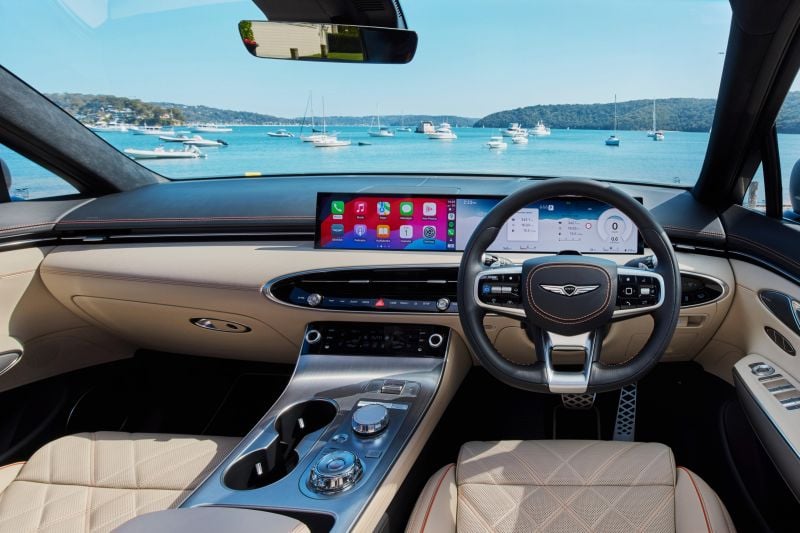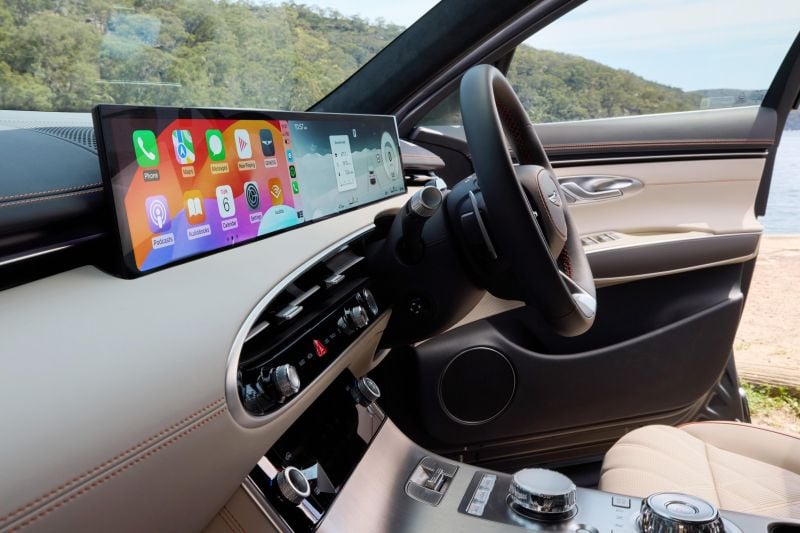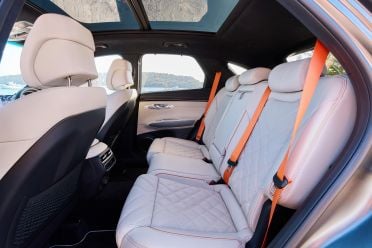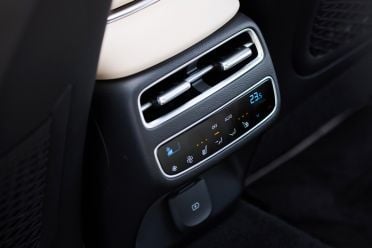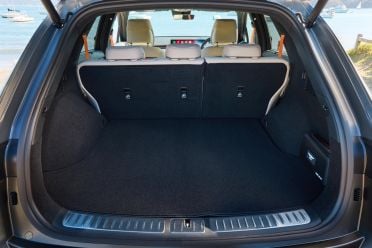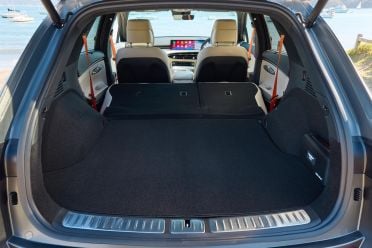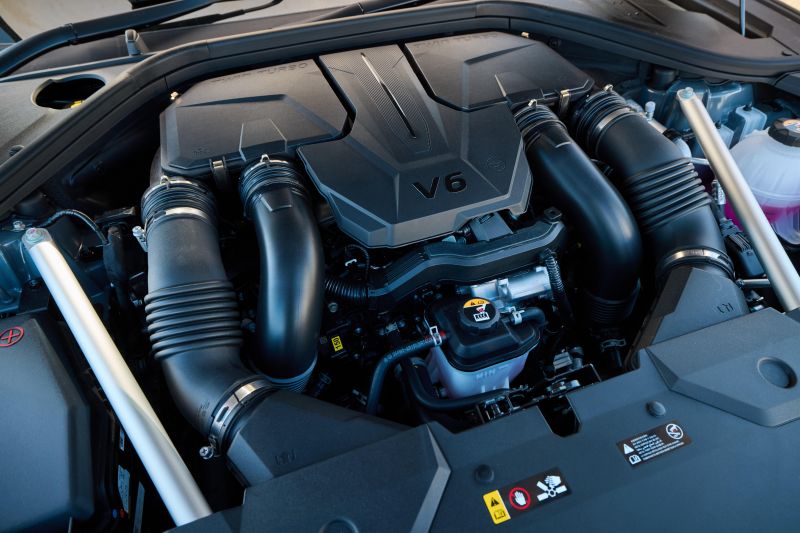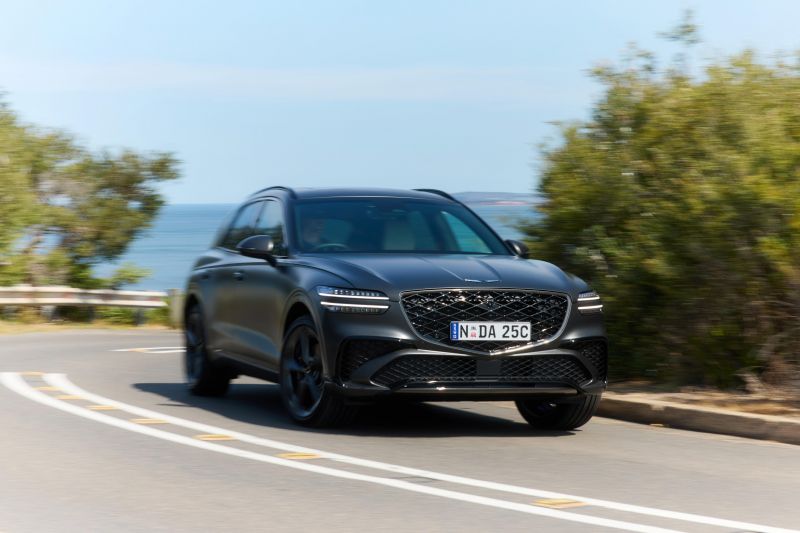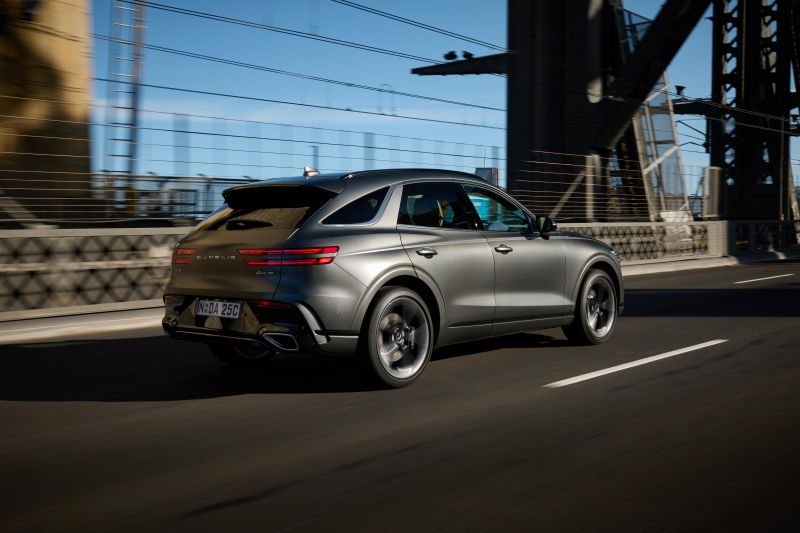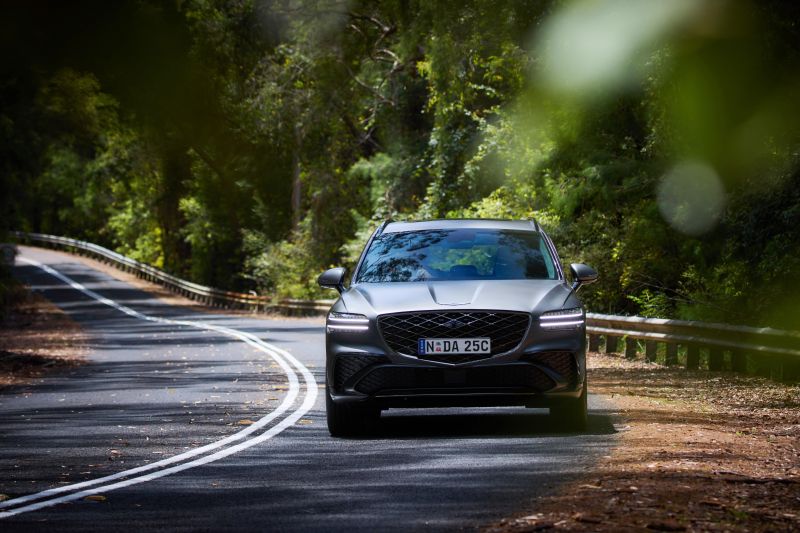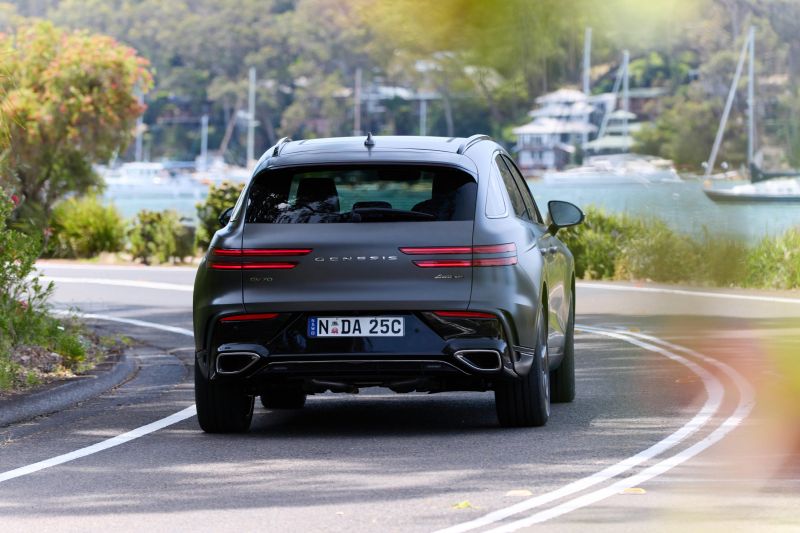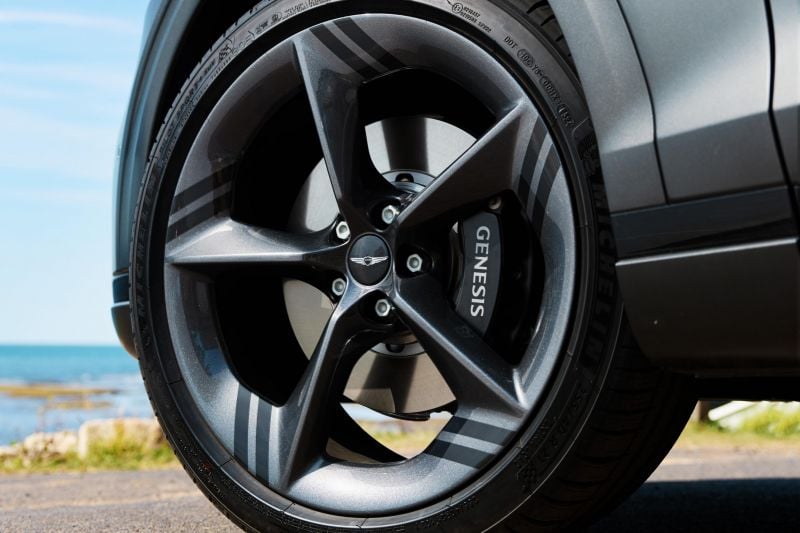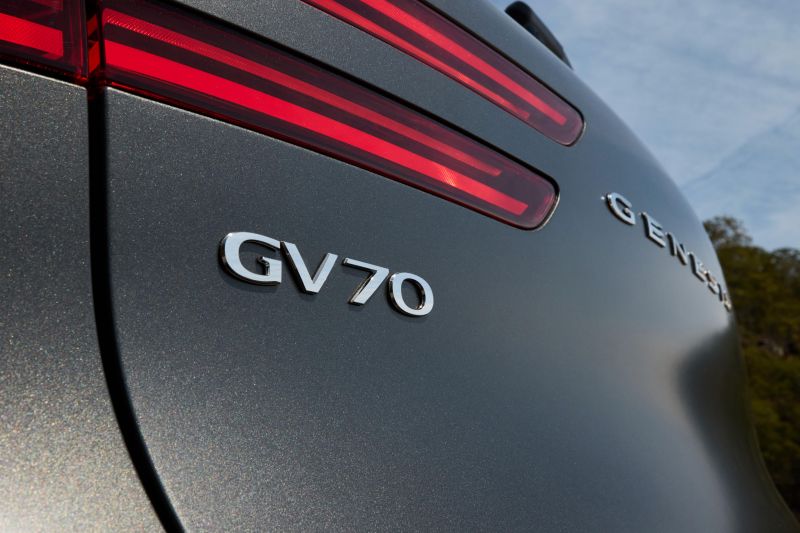The Genesis GV70 is Korea’s alternative to the Audi Q5, BMW X3, Lexus NX and Mercedes-Benz GLC, and while it doesn’t sell as well as those popular mid-size luxury SUVs, it ought to be on your shortlist.
It’s always nice to see a brand keeping more established players honest. Whether it’s Lexus swooping in in the 1990s to take on the Germans, or BYD today trying to take down Tesla, it’s great to see a disruptor.
While Genesis’ sales volumes are still well below those of Audi, BMW, Mercedes-Benz or even Lexus, it has provided some more compelling competition for the luxury establishment.
The GV70 is its best-seller, not just because the medium SUV segment is Australia’s largest, but likely because it’s Genesis’ most compelling vehicle.
The G70 medium sedan and wagon are too cramped, the GV60 small electric SUV is a bit too eccentric, the G80 is a large sedan in an SUV world, and the GV80 large SUV has gotten more expensive.
WATCH: Paul’s video review of the 2022 Genesis GV70 3.5T AWD
Last year, Genesis gave the GV70 a mid-life update. Exterior changes include a restyled grille, new wheels, and headlights with Micro Lens Array (MLA) technology, along with reversing lights that have thankfully moved from the bumper up to the tail lights.
Even more substantial changes can be found inside the luxury SUV’s cabin, too – more on that later.
Genesis differs from most rival brands in offering an enormous amount of standard kit in even its most affordable models, while also including a generous after-sales package.
Should more buyers be considering this still fairly unfamiliar brand?
How does the Genesis GV70 compare?
View a detailed breakdown of the Genesis GV70 against similarly sized vehicles.

Genesis
GV70
How much does the Genesis GV70 cost?
With the entry-level rear-wheel drive model being cut as part of the GV70’s mid-life update, the base price climbed by $8000.
| Model | Price before on-road costs |
|---|---|
| 2025 Genesis GV70 Advanced 2.5T | $78,500 |
| 2025 Genesis GV70 Signature 2.5T | $87,500 |
| 2025 Genesis GV70 Signature Sport 2.5T | $89,500 |
| 2025 Genesis GV70 Signature 3.5T | $98,000 |
| 2025 Genesis GV70 Signature Sport 3.5T | $100,000 |
Genesis also reshuffled the GV70 lineup further, introducing the Advanced, Signature and Signature Sport trim levels.
The latter two effectively have the contents of the former Luxury Package – previously a $7100 option – standard fitment. Throw in some new features like a better sound system and infotainment and the flagship GV70 is now around $16,000 more expensive than before.
Even when compared with the model year 2024 (MY24) 3.5T AWD Sport with the optional Luxury Package, you’re looking at close to a $10,000 price hike.
Despite this, it still ends up being significantly cheaper than similarly powerful German SUVs such as the BMW X3 M50 xDrive ($128,900 before on-roads) and Audi SQ5 ($124,315 before on-roads).
To see how the Genesis GV70 lines up against the competition, check out our comparison tool
What is the Genesis GV70 like on the inside?
Unlocking the GV70 is the first hurdle. Genesis has moved away from buttons on the door handles, and instead you simply grasp the handle with the key in your pocket and it’ll unlock.
In theory, that is. You have to grip it properly, or otherwise you’ll experience what we did on a couple of occasions, where pulling the handle doesn’t unlock the vehicle and the indicators flash to tell you that yes, it’s still locked.
That silliness aside, step inside the GV70 and you’re greeted with one very attractive cabin.
From the quilted Nappa leather to the brushed metal accents and the orange highlights, including bold orange seatbelts, the GV70 looks terrific inside. We wouldn’t have thought black, cream and orange would go together as well as it does here.
If the orange is too much for you, there are other available colourways that do without the upbeat colour.
Where rival Japanese and German brands cut corners by using hard plastic for the glove box lid, the bottoms of doors and even the door tops in some instances, Genesis has used spongy, soft-touch stuff. Nice. There’s also soft-touch trim atop the dash.
It makes it all the more baffling, then, that the material across the front of the dash and the sides of the centre console which looks like it’s soft in fact isn’t. Instead, it’s hard plastic, despite looking attractive and featuring neat stitching details.
Sure, you mightn’t be poking and prodding your car’s dashboard all that much, but you will probably rest your knee against the hard plastic.
Despite these faux pas, the interior is well-built and there are some lovely items like the weighty rotary dial for gear selection and the knurled metallic switchgear on the tactile steering wheel.
Speaking of the steering wheel, the only part we don’t care for is the little touch-sensitive square you swipe over to skip tracks. It’s a lot harder to use than the simple scroll wheel for volume.
The key change with the GV70’s mid-life update was the move to a 27-inch OLED display that incorporates the infotainment touchscreen and digital instrument cluster.
Previously, the GV70 had a 14.5-inch touchscreen and either an 8.0-inch instrument cluster screen with analogue gauges or a 12.3-inch digital instrument cluster with a 3D look. The latter was elegant, but the new setup blows it out of the water.
You can have the embedded maps now appear across the entire 27-inch display. Not only that, but you can have Waze and Google Maps appear on the instrument cluster as well as the touchscreen, though the map won’t extend across the entire display like with the embedded navigation.
The real show-stopper though is the augmented reality navigation, which displays camera footage from in front of the vehicle. Blue lines and arrows are overlaid to indicate the route, while a large red bar will appear if you cross a lane marking.
It feels like playing Need for Speed, and is well-executed to the point of being admittedly a little distracting. Turn-by-turn instructions also appear in the head-up display.
The infotainment system itself is easy to navigate and boasts attractive graphics, and it contains neat functions you may never use like a quiet mode (muting the rear speakers), a voice memo app, and a BMW-style Mood Curator that plays music and adjusts the lighting and fragrance.
While Apple CarPlay and Android Auto still required a cable to connect at launch, an update has subsequently been made available.
The mid-life update also brought a restyled centre stack. There’s still an oval-shaped array, but this now incorporates the centre air vents and touch-capacitive shortcuts for the infotainment system.
The climate controls have been moved further down and, while largely consisting of touch-capacitive switches, still uses proper, tactile knobs for temperature adjustment.
There’s attractive brushed metal-looking trim on the centre console (see, rivals – not everything has to be piano black!) with some nice details like a redundant rotary dial for the infotainment and a little rocker switch for drive mode selection.
There’s a wireless phone charger, while the centre console bin has a pair of USB-C outlets.
All the usual Genesis highlights are still present and accounted for, including tasteful ambient lighting and high-resolution cameras. There’s also a panoramic sunroof that is extremely tinted – great for keeping out heat, not so great for enjoying the view out.
The move to a Bang & Olufsen sound system is most welcome. It’s not that the old Lexicon system was bad, but Bang & Olufsen systems are always excellent and on several occasions I made this car my mobile karaoke booth.
The front seats are extremely comfortable, with 18-way power adjustment, memory, heating, ventilation, and three different massage modes.
Step into the back and there’s enough room for someone 180cm tall sitting behind someone of the same size. Both headroom and legroom are decent.
There’s a bit of a driveline hump, which does eat into legroom for the centre-seat occupant.
At the rear of the centre console there are air vents, climate and heated seat controls, plus two USB-C outlets. Child seats can be fitted using one of two ISOFIX or one of three top-tether anchor points.
The boot isn’t going to win any size contests. The floor area is fairly large, but the rakish tailgate means you may struggle with larger and bulkier items.
Back here, you’ll find levers to drop the rear seats, plus a 12V 180W power outlet. Under the floor is a temporary spare.
The tailgate has hands-free functionality, which is handy while you’re juggling shopping bags, while the reversing guide lights projected on the ground are great for warning other shoppers of your presence.
Someone park too close to you? You can use Remote Smart Parking Assist, allowing you to use the key fob to move the vehicle forward and backwards. It’s a clever feature that you’ll also find on certain Hyundai and Kia models.
| Dimensions | Genesis GV70 |
|---|---|
| Length | 4715mm |
| Width | 1910mm |
| Height | 1630mm |
| Wheelbase | 2875mm |
| Cargo capacity | 542L (seats up) 1678L (second row folded) |
To see how the Genesis GV70 lines up against the competition, check out our comparison tool
What’s under the bonnet?
While the GV70 can also be had with a 2.5-litre turbocharged four-cylinder petrol engine and even a dual-motor electric powertrain, we tested the 3.5-litre twin-turbo V6.
| Specifications | Genesis GV70 3.5T AWD |
|---|---|
| Engine | 3.5L V6 twin-turbo petrol |
| Power | 279kW @ 5800rpm |
| Torque | 530Nm @ 1300-4500rpm |
| Transmission | 8-speed auto |
| Drive type | All-wheel drive |
| Weight | 2088kg |
| Fuel economy (claimed) | 11.3L/100km |
| Fuel economy (as tested) | 10.5L/100km (inner-city, suburban, highway loop) 12.5L/100km (over ~500km of driving) |
| Fuel tank capacity | 66L |
| Fuel requirement | 95 octane premium unleaded |
| CO2 emissions | 257g/km |
| Emissions standard | Euro 5 |
| Braked tow capacity | 2200kg |
To see how the Genesis GV70 lines up against the competition, check out our comparison tool
How does the Genesis GV70 drive?
The GV70 may have some heady performance figures, but it’s at its most impressive as a cruiser.
It has a loping ride quality that smooths out bumps and ruts while maintaining good body control. That’s impressive given this rides on big 21-inch alloy wheels.
There’s a lot of grunt on tap, but power is delivered smoothly. The transmission shifts unobtrusively for the most part, though coming to a halt reveals the shifts into second and then first can be a bit more pronounced than other shifts.
The cabin is impressively hushed at all speeds. You can give the GV70 an artificially enhanced engine note by toggling the Active Sound Design feature, but we eventually turned this off.
It’s not annoying, but given the GV70 has such an inoffensive V6 engine note and the cabin is so wonderfully quiet, it seemed a bit pointless.
That said, we appreciate how you can alter the character of the GV70. There are selectable Eco, Comfort, Sport, Sport+ and Custom drive modes, the latter allowing you to adjust the powertrain, steering and suspension.
In the adaptive dampers’ firmest setting, the GV70 feels more hunkered down and athletic but with little penalty to ride comfort.
We took the GV70 for a spirited mountain drive and were impressed with the lack of body roll and the generally quite nimble feeling this SUV has.
The all-wheel drive system helps keep you glued securely to the road, but it is noticeably rear-biased – and all the better for it. This is a car that’s enjoyable in the twisties, with the Sport modes adding some noticeable heft to the steering too.
Not that it needs it – the GV70’s steering is nicely weighted by default. And while it can hang with its German rivals on a winding road, settling back into a highway cruise shows how Genesis hit the key requirements for a luxury SUV.
On the highway, the GV70’s combination of adaptive cruise control and lane centring systems make for easy cruising. There’s also a lane change assist function, but it’ll scold you for taking your hands off the wheel and cancel if it detects too much steering movement, so it’s a bit pointless.
While we appreciate how the Lane Following Assist keeps the car centred in its lane, the standard lane-keep assist system proves too intrusive when you’re just driving around town and unlike some rivals you can’t toggle between different levels.
Fortunately, you can turn this off with the press of a steering wheel button.
Genesis has also rolled out an update for the GV70 that allows you to hold down the steering wheel mute button and turn off the annoying speed limit assist feature.
However, while this mutes the overspeed alert, the GV70 still sounds a chime whenever you enter a new speed limit zone – a useless feature if we’ve ever heard of one.
To turn this off, you’ll have to do the typical Hyundai dash of programming one of the steering wheel buttons to take you to the driver assist menu. That’s a minimum of three button presses which you’ll have to do every time you restart the vehicle.
The driver attention monitoring is less annoying and is generally pretty accurate, only chiming when I looked, for example, at the screen for too long.
To see how the Genesis GV70 lines up against the competition, check out our comparison tool
What do you get?
The 2025 Genesis GV70 is available in three trim levels – Advanced, Signature, and Signature Sport.
-
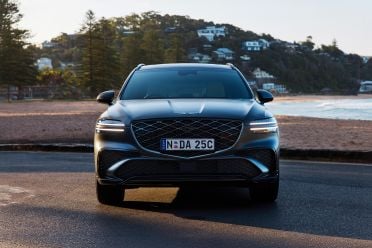
3.5T Sport Signature shown -
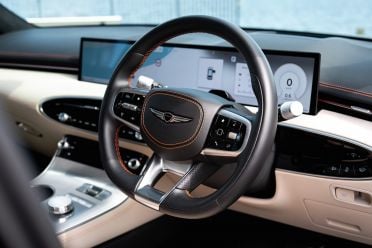
-
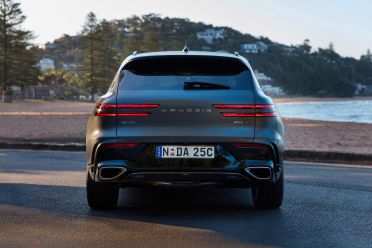
-
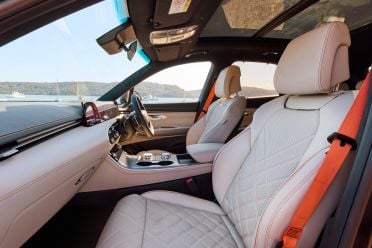
2025 Genesis GV70 Advanced equipment highlights:
- 19-inch alloy wheels
- Temporary spare
- LED headlights
- Launch control
- Multi-terrain mode
- Paddle shifters
- Rain-sensing wipers
- Proximity entry with push-button start
- Privacy glass
- Hands-free power tailgate
- Power-folding, heated exterior mirrors
- Panoramic sunroof
- Remote start
- Remote Smart Parking Assist 2
- 27-inch integrated infotainment and instrument cluster display
- Wireless Apple CarPlay and Android Auto
- Satellite navigation
- Head-up display
- 9-speaker sound system
- DAB+ digital radio
- Wireless phone charger
- Dual-zone climate control
- 6.0-inch control panel
- Rear control panel
- Leather-wrapped steering wheel
- Leather upholstery
- 12-way power-adjustable front seats
- Heated and ventilated front seats
- Power-adjustable tilt and telescopic steering column
- Memory for steering wheel, mirrors, head-up display and driver’s seat
- Easy Access function for driver’s seat, steering wheel
- Cloth headliner
- Colour-adjustable ambient lighting
GV70 Signature adds:
- 21-inch alloy wheels
- Adaptive high-beam
- 16-speaker Bang & Olufsen sound system
- Active noise control
- Nappa leather upholstery
- 18-way power-adjustable front seats
- Massaging front seats
- Passenger memory
- Heated rear seats
- Heated steering wheel
- Air aroma diffuser
- Rear climate control zone
- Suede headliner
GV70 Signature Sport adds:
- Sport+ drive mode
- Sport-exclusive seats
- Dark chrome exterior trim
- Stainless steel pedals
- Monoblock black brake calipers
Variants with the 3.5T engine also gain adaptive dampers and an electronically controlled limited-slip differential.
All models also come with a five-year complimentary subscription to Genesis Connected Services
Genesis Connected Services includes:
- Emergency call function
- Automatic collision notification
- Extended voice recognition
- Remote control of climate settings, surround-view camera
Is the Genesis GV70 safe?
While all other GV70 models have a five-star safety rating from ANCAP, based on testing conducted in 2021, the 3.5T has never been rated by the independent auto safety body.
Standard safety equipment across the range includes:
- Autonomous emergency braking (AEB)
- Car, pedestrian and cyclist detection
- Junction and lane-change oncoming/side assist
- Evasive steering assist
- Blind-spot assist
- Highway Driving Assist 2
- Blind-Spot View Monitor
- Lane-keep assist
- Lane Following Assist (lane centring)
- Rear cross-traffic assist
- Intelligent speed limit assist
- Safe exit assist
- Adaptive cruise control
- Navigation-based smart cruise control
- Stop/go
- Overtaking Acceleration Assist
- Driver attention monitoring
- Safe exit assist
- Sensor-based rear occupant alert
- Surround-view camera with 3D view
- Front and rear parking sensors
- Parking collision avoidance
- Projected reversing lights
- Eight airbags (front, front-side, curtain and front-centre)
- Active bonnet
- Projected reversing lights
- Tyre pressure monitoring
How much does the Genesis GV70 cost to run?
It’s hard to beat the GV70’s aftersales package.
| Servicing and Warranty | Genesis GV70 |
|---|---|
| Warranty | 5 years, unlimited kilometres |
| Roadside assistance | 10 years – service-activated |
| Service intervals | 12 months or 10,000km |
| Capped-price servicing | 5 years or 50,000km |
| Total capped-price service cost | Complimentary |
Not only do you get five years of free servicing, but live within 70km of a Genesis outlet a member of the company’s concierge team will pick up your car for its service and leave you with a Genesis courtesy car.
To see how the Genesis GV70 lines up against the competition, check out our comparison tool
CarExpert’s Take on the Genesis GV70
The Genesis GV70 is poised, refined, loaded with tech and elegantly styled inside and out.
Our twin-turbo V6 tester, however, proved a bit thirsty. And given the GV70 is such a comfortable cruiser rather than an AMG wannabe, such a powerful engine feels almost unnecessary.
At first it seems the $11,500 difference between our tester and a comparably equipped four-cylinder turbo model is too steep, though a closer look reveals that – on paper at least – the four-cylinder isn’t that much more efficient, and you also miss out on adaptive suspension and an e-LSD.
So, if you want to splurge, go ahead. You’re still getting performance comparable to an X3 M50 or AMG GLC 43 for around $20-30,000 less, with more equipment, a better aftersales package, and more technology.
Interested in buying a Genesis GV70? Get in touch with one of CarExpert’s trusted dealers here
Click the images for the full gallery, with additional imagery by Eliot Tsai
MORE: Everything Genesis GV70




